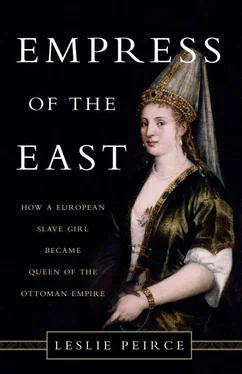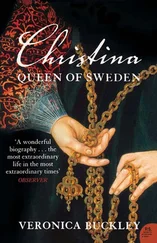Subjects of the Ottoman empire understood and honored the political logic of serial concubinage—rotation out of the sultan’s bed of each new mother of a son. They grasped the point that a prince should not share his mother with another prince, that his mother was both his ally and the sultan’s check on his son’s loyalty. The contest among princes was expected to be even, and each needed and deserved his mother’s exclusive devotion and counsel. Heir to political traditions shared by Mongols and Central Asian Turks, the Ottomans believed that all physically sound sons of the sovereign had an equally legitimate claim to power. The widespread European practice of primogeniture—the automatic succession of the king’s eldest son—no doubt seemed to them both unjust and unwise. First there was the spiritual belief that sovereignty was god given and man should not interfere, and then there was the mundane rationale that casting sons of the reigning monarch as rivals would demonstrate who was best able to rally a loyal following and win the backing of the military, thus the best candidate to succeed his father. To the public, it must have seemed dangerous to tamper with a formula that had yielded a stellar succession of strong monarchs.
But the times were dangerous. It was immediately after he threw down the gauntlet to Europe at Belgrade that Suleyman lost three children. In 1522, the ambassador Minio commented that the empire would be in great confusion should the sultan happen to die leaving only infant heirs. [12] Alberi, Relazioni , 3:78.
A crisis in the life of the dynastic family was a crisis in the state, and Europe had used such moments in the past to assemble crusading coalitions against the Ottomans. The famous Battle of Varna in 1444 was a case in point. When Murad II gave up the throne for a life of contemplation, turning it over to his twelve-year-old son Mehmed (the future “Conqueror”), a coalition of several kings and princes blessed by the pope saw an opportunity to advance. Fortunately for the Ottomans, Murad returned at the grand vizier’s summons and vanquished the crusaders.
Although Suleyman could do nothing about the tender age of his offspring, he clearly had to father more as insurance against the myriad hazards of childhood in the sixteenth century. His viziers would have impressed this upon him in guarded, respectful terms, his mother more emphatically. Suleyman was not alone in his dilemma, for the quest for heirs bedeviled other monarchs in these years. In 1525, Basil III, grand prince of Moscow, confined his wife to a convent after twenty years of a childless marriage; four years later, in a second union, he finally got his son, the future Ivan IV. The Tudor kings of England were stymied in their efforts to establish a new dynasty in the aftermath of the internecine slaughter that had been the Wars of the Roses. The first Tudor ruler, Henry VII, lost his eldest son, Crown Prince Arthur, when the boy was fifteen. Henry VIII, Arthur’s younger brother and successor, waited twenty-eight years for his own male heir.
Henry VIII was notorious for the lengths he went to get a son—a divorce that precipitated a rupture with the pope in Rome in 1533, the execution in 1536 of an alleged adulteress who had only produced a girl. If Basil and Henry knew of the Ottoman monarch’s plight, he must have looked lucky to them: he did not have to rid himself of his consorts to obtain the sons who brought dynastic security.
WHAT PERSUADED SULEYMAN to answer his own reproductive crisis by reuniting with Roxelana? Of all our uncertainties about Suleyman and Roxelana’s relationship, this is the most vexing. Returning the mother of a prince to the role of concubine violated his ancestors’ long-standing practice. It was an act that would reset the course of Roxelana’s life and forever change the face of Ottoman politics.
What part, if any, Roxelana played in stimulating her reunion with Suleyman is also unclear. She may well have been loath to see another woman in Suleyman’s bed now that she had a son whose future she must protect. A new concubine could mean a new son for the sultan and a competitor for her Mehmed. And if Roxelana had become emotionally attached to Suleyman, she had all the more reason to resist a rival. On the other hand, perhaps she was content simply to focus on Mehmed and their future together.
What was Suleyman thinking when he shared his bed again with Roxelana? Was he heedlessly following his heart, as his critics would later claim? Was it simply easier for him, in the midst of personal grief and the relentless press of politics, to turn to a woman now familiar to him than to initiate a barely known and inexperienced virgin? Ottoman politics of reproduction exacted a price from a male dynast, who by convention had to relinquish a concubine he might have come to care for. Whatever the case, the pressure for more sons was certainly a factor in Suleyman’s decision to bend the rules for a woman who had conceived quickly and produced a healthy boy.
Still, as the young sultan well knew, to flout imperial custom was a hazardous move. Abandoning the practice of rotating concubines would disrupt delicate power balances worked out over two centuries. The Old Palace prided itself on providing sultans with multiple partners worthy of companionship and motherhood, and resentment of Suleyman’s return to Roxelana would naturally arise in some quarters. His pashas and viziers must have worried that the unprecedented devotion to a single woman—especially a young and politically inexperienced one—would interfere with his political judgment. Even more consequential, compelling Roxelana’s sons to share the political asset that was their mother threatened to give the competitive advantage to Mustafa. As ambassadors noted, his mother Mahidevran was wholly focused on his success. On the other hand, a son of Suleyman’s favorite might be unfairly favored in the game of rivalry for the throne.
It matters why Suleyman ignored long-established custom when he returned to Roxelana after Mehmed’s birth, for this decision would turn out to be the first in a chain of events that ultimately altered the manner of succession to the throne and the very nature of the Ottoman sultanate. Even before becoming sultan, Suleyman had legitimate reason for thinking that his ancestors’ methods of perpetuating the dynasty called for reconsideration. During the eight years of his princely apprenticeship, he had had a good deal of time to both experience the vagaries of imperial politics and reflect on them. His father’s path to the Ottoman throne had been a whirlwind of violence and victory.
Selim I’s tenure as sultan began in 1512 with the forcible overthrow of his father Bayezid II. The allegation that Selim had the sultan poisoned—Bayezid perished on his way to forced retirement—has been neither proved nor disproved. Selim then proceeded to battle his two older brothers, both of whom, like himself, had connived for the throne. After defeating and executing both, Selim had his agents hunt down and kill their sons. He then ordered the execution of the male offspring of other brothers previously deceased. There were many, since Bayezid had numerous children, eight of whom were male. Moreover, Bayezid had lived long enough to give his own sons plenty of time to reproduce—he was sixty-eight by the Islamic calendar when he died. By the spring of 1513, Selim had eliminated all branches of the dynastic family except his own. As for Suleyman, he was indirectly his father’s accomplice in the bloodbath, as Selim appointed him deputy ruler in the capital while he pursued his rival relatives.
Selim was no monster, however. It was his grandfather Mehmed the Conqueror who had sanctioned internecine violence with his so-called law of fratricide, approved by religious authorities (possibly under duress). Sovereignty must be indivisible and the sovereign unchallenged. As history had cautioned, empires that embraced the principle that all male dynasts had a right to rule—the Seljuks, the Mongols—could fragment into feuding factions, fatally weakened by incessant combat among royal brothers, cousins, and uncles. The House of Osman itself had struggled from the beginning with the ill-matched principles of unitary sovereignty and competitive succession. It took Mehmed’s authority to push through a legislated solution. Still, if legitimate by law and tradition, Selim’s contest with his brothers was the most violent on record since the long civil war of 1402 to 1412 had threatened partition of the state among Ottoman princes.
Читать дальше












